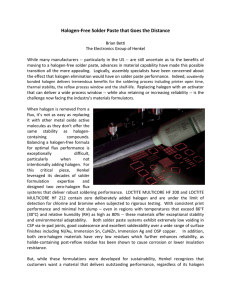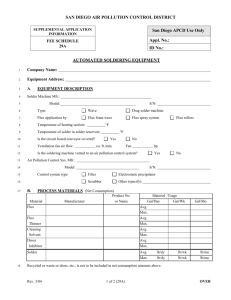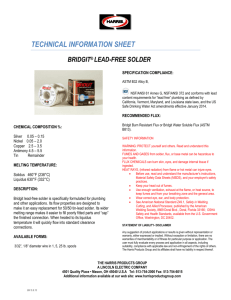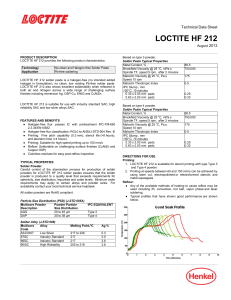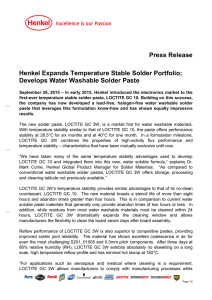High-Reliability Meets Pb-free and Halogen - Henkel
advertisement
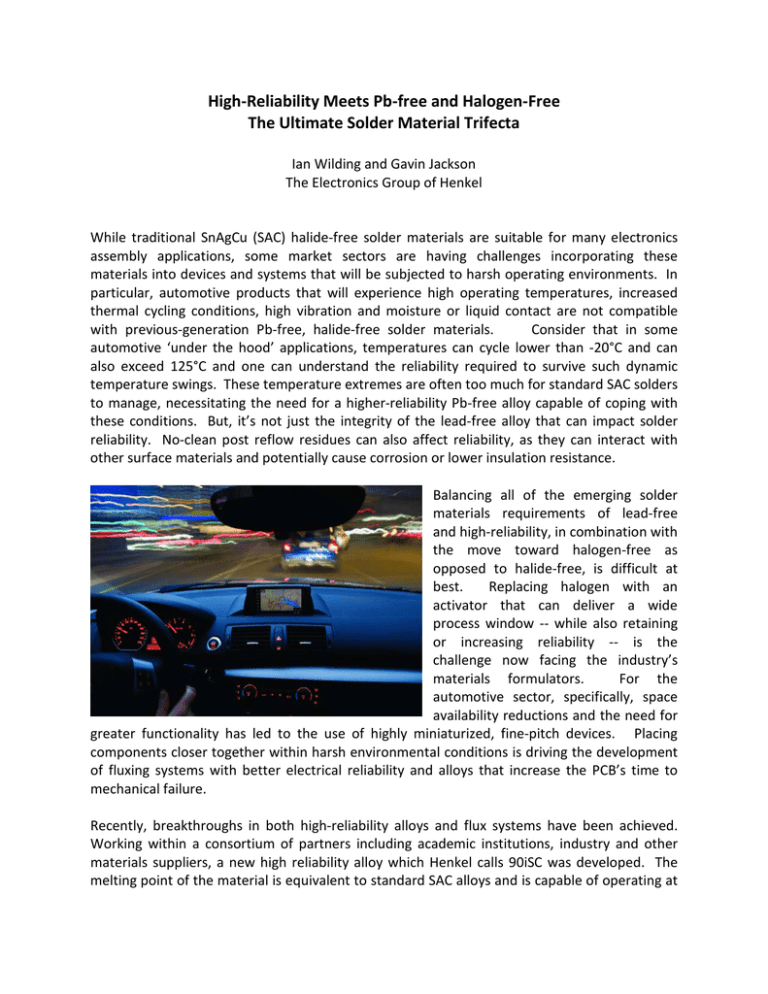
High-Reliability Meets Pb-free and Halogen-Free The Ultimate Solder Material Trifecta Ian Wilding and Gavin Jackson The Electronics Group of Henkel While traditional SnAgCu (SAC) halide-free solder materials are suitable for many electronics assembly applications, some market sectors are having challenges incorporating these materials into devices and systems that will be subjected to harsh operating environments. In particular, automotive products that will experience high operating temperatures, increased thermal cycling conditions, high vibration and moisture or liquid contact are not compatible with previous-generation Pb-free, halide-free solder materials. Consider that in some automotive ‘under the hood’ applications, temperatures can cycle lower than -20°C and can also exceed 125°C and one can understand the reliability required to survive such dynamic temperature swings. These temperature extremes are often too much for standard SAC solders to manage, necessitating the need for a higher-reliability Pb-free alloy capable of coping with these conditions. But, it’s not just the integrity of the lead-free alloy that can impact solder reliability. No-clean post reflow residues can also affect reliability, as they can interact with other surface materials and potentially cause corrosion or lower insulation resistance. Balancing all of the emerging solder materials requirements of lead-free and high-reliability, in combination with the move toward halogen-free as opposed to halide-free, is difficult at best. Replacing halogen with an activator that can deliver a wide process window -- while also retaining or increasing reliability -- is the challenge now facing the industry’s materials formulators. For the automotive sector, specifically, space availability reductions and the need for greater functionality has led to the use of highly miniaturized, fine-pitch devices. Placing components closer together within harsh environmental conditions is driving the development of fluxing systems with better electrical reliability and alloys that increase the PCB’s time to mechanical failure. Recently, breakthroughs in both high-reliability alloys and flux systems have been achieved. Working within a consortium of partners including academic institutions, industry and other materials suppliers, a new high reliability alloy which Henkel calls 90iSC was developed. The melting point of the material is equivalent to standard SAC alloys and is capable of operating at temperatures up to 150°C, thereby offering a high temperature-compatible solution for automotive device manufacturers. The alloy is also complies with RoHS legislation and contains no toxic or cost-prohibitive elements. What’s more, the new alloy offers significant improvements over both standard SAC and SnPb alloys. But, obviously the alloy alone cannot carry out the job of soldering. The flux formulation underpins the comprehensive performance of the solder material and determines its printing characteristics, reflow performance and electrochemical reliability of the final assembly. When halogen is removed from a flux, it’s not as easy as replacing it with other metal oxide active molecules as they don’t offer the same stability as halogen-containing compounds. Balancing a halogen-free formula for optimal flux performance is exceptionally difficult, particularly when not intentionally adding halogen. For this critical piece, Henkel leveraged its decades of solder formulation expertise and designed two zero-halogen flux systems that deliver robust soldering performance. LOCTITE MULTICORE HF 200 and LOCTITE MULTICORE HF 212 contain zero deliberately added halogen and are under the limit of detection for chlorine and bromine when subjected to rigorous testing. With consistent print performance and minimal hot slump – even in regions with temperatures that exceed 86°F (30°C) and relative humidity (RH) as high as 80% -- these materials offer exceptional stability and environmental adaptability. Both solder paste systems exhibit extremely low voiding in CSP via-in-pad joints, good coalescence and excellent solderability over a wide range of surface finishes including Ni/Au, Immersion Sn, CuNiZn, Immersion Ag and OSP copper. LOCTITE MULTICORE HF 200 and LOCTITE MULTICORE HF 212 can be used with the 90iSC high-reliability alloy for the ultimate in lead-free, halogen-free paste performance for even the most demanding applications. In addition, both zero-halogen materials have very low residues which further enhances reliability, as halide-containing post-reflow residue has been shown to cause corrosion or lower insulation resistance. The increasing demands on solder paste materials now require formulas that are sustainable, environmentally compliant, highly reliable and easy to process. The automotive sector is even more challenging, with miniaturized designs and under the hood applications requiring new levels of thermal cycle and thermal shock resistance. Henkel’s new halogen-free flux platforms offer excellent performance and a reduced risk of electrochemical failures that are often associated with halide-containing post-reflow flux residues. When combined with the company’s new high-reliability alloy, 90iSC, the result is a robust solder paste system capable of addressing the emerging trends of harsh environments and safety-critical electronics. For more information on Henkel’s halogen-free materials, LOCTITE MULTICORE HF 200 and LOTCITE MULTICORE HF 212, or its new high-reliability Pb-free alloy, 90iSC, log onto www.henkel.com/electronics or call 1-888-943-6535 in the Americas, +32 1457 5611 in Europe or +86 21 3898 4800 in Asia.

